|
S10 Password Vault lets you auto-login to any website or program with account info stored securely on your PC. You can set up accounts to login upon launch, or use the following commands from within any field in any website or program to auto-type the appropriate info:
Free for personal use. Donations appreciated. Low-cost business licenses.
|
|
|||||||||||||
 Downloads - The program is available for Windows as a standard installer and as a portable version that allows you to run directly from a USB drive (which then also contains your data file). There is also an "S10 Vault" mobile companion app for iPhone/iPad (in the App Store) and for Android devices (in the Google Play Store and Amazon App Store).
Downloads - The program is available for Windows as a standard installer and as a portable version that allows you to run directly from a USB drive (which then also contains your data file). There is also an "S10 Vault" mobile companion app for iPhone/iPad (in the App Store) and for Android devices (in the Google Play Store and Amazon App Store).Easy to use - Small and simple windows, unlike other programs that often use large cluttered windows. No ugly browser toolbars either. Works with any program, not just browsers. You no longer have to remember all your usernames/passwords, and you don't have to switch back-and-forth between windows to copy/paste them either, thanks to the convenient autotype feature.
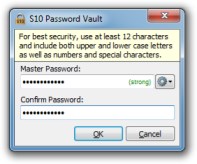 Master password - The first step is to create a master password which you will use to access your password vault. For good security, the master password should be long and use a mix of lower and upper case letters, numbers, and special characters. You can use a phrase or sentence instead of just one word; the longer it is, the more secure it is. But beware that there is no way to recover or reset a forgotten password; your information is effectively lost if you cannot remember your master password - there is no back door.
Master password - The first step is to create a master password which you will use to access your password vault. For good security, the master password should be long and use a mix of lower and upper case letters, numbers, and special characters. You can use a phrase or sentence instead of just one word; the longer it is, the more secure it is. But beware that there is no way to recover or reset a forgotten password; your information is effectively lost if you cannot remember your master password - there is no back door.Single data file - Your data is stored in a single vault file locally on your PC (by default "Password Vault.s10p" in your Documents folder). Be sure your backup software includes this file, or manually back up the file in a safe place on a regular basis. If your hard drive crashes, just restore this file and reinstall the program (and, if you made a donation, also restore the s10_Donation.txt file). To create/open a different vault file, click the options button next to "Master Password" and click "Select Vault File".
Military grade encryption - Your vault file is securely encrypted using the very strong standard 256-bit AES algorithm which is roughly a trillion trillion trillion trillion trillion times stronger than what has ever been cracked. For maximum security, the Change Password screen lets you supplement your password with a generated key file on a USB drive; this eliminates any danger posed by password-cracking utilities. For further technical information, see the full encryption details.
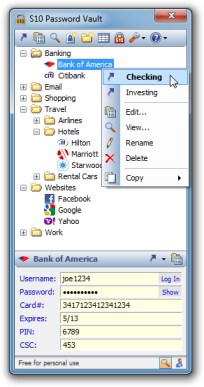 Folder/account hierarchy - The second step is to add your accounts (username/password pairs and related information) which you can organize any way you like; use the default folder structure or add/rename/delete folders to create your own structure. Use drag-and-drop to easily rearrange folders and accounts. For quick access when you have a large number of accounts, it supports jump-to-next-match keystroke searching. For free-text search, go to the View All window.
Folder/account hierarchy - The second step is to add your accounts (username/password pairs and related information) which you can organize any way you like; use the default folder structure or add/rename/delete folders to create your own structure. Use drag-and-drop to easily rearrange folders and accounts. For quick access when you have a large number of accounts, it supports jump-to-next-match keystroke searching. For free-text search, go to the View All window.
At the bottom of the window there is an optional panel showing details for the selected account, offering launch, autotype, and drag-and-drop. A second optional panel is available for Personal Info fields (set up via the Tools menu). These panels can be toggled on/off via the two icons at the bottom right corner.
Launch websites and programs - For each account, you can specify a corresponding website address or program file, which you can then easily launch later. You can even specify multiple websites or programs; this is useful if the username/password is used as a login for more than one place. Use of variables in the launch command is also supported (%Username%, %Password%, and custom fields, e.g., %PIN%). Additionally, S10 Password Vault can optionally log you in automatically to the website/program upon launch - see "Login Sequence" below.
Copying usernames/passwords - The context menu lets you easily copy the username or password for an account onto the clipboard. However, in most cases, using one of the autotype commands is actually much quicker than copying and pasting. For security reasons, the clipboard is automatically cleared after 1 minute.
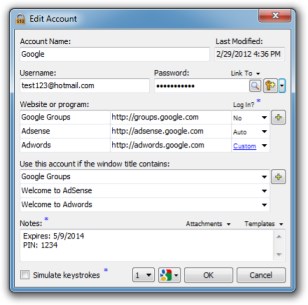 Password generation - Since you no longer have to remember all your individual passwords, it is a good idea to start using more complex passwords for better security. S10 Password Vault can generate strong, random passwords that you can use for your accounts.
Password generation - Since you no longer have to remember all your individual passwords, it is a good idea to start using more complex passwords for better security. S10 Password Vault can generate strong, random passwords that you can use for your accounts.Linked passwords - If you want to set up an accounts that should always use the same password as another account, you can link the password to the other account. This way you can maintain the password in one place (the "master" acocunt).
Title/account matching - Each account can be associated with one or more window titles (full or partial). When you use an autotype command, S10 Password Vault checks the window title of the current website/program and tries to find a matching account. If there are multiple matching accounts, it also checks the server name in the URL in order to find the strongest match.
Custom fields - In the Notes section at the bottom of the Edit Account window you can define custom fields (Name:Value), for example to track things like account numbers, expiration dates, PINs, addresses, etc. Just like username and password, this information is then easily accessible via autotype, drag-and-drop, and copying.
The Templates button lets you pick from a customizable list of pre-defined account types (Bank Account, Credit Card, etc.)
The Attachments button lets you add files to be stored safely along with the account. An attachment is opened with the default program configured for the file extension, and it allows you to make changes without having to re-attach the file. To remove an attachment, highlight the item and hit the Delete key.
Account Icons - At the bottom of the window you can choose an icon for your account. Icons are automatically extracted from entered program files and website addresses. For websites, it will first try to get the icon from the Internet Explorer local cache, and also gives you an option to request to retrieve it online.
Quick Launch Keys - For frequently used accounts, you may want to assign a quick-launch key so that you can launch it with a single keystroke. Numbers 1-9 can be assigned.
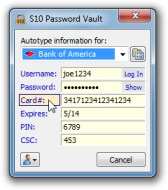 Auto-type commands - As listed at the top of this page, there are dedicated autotype commands for the most common scenarios: AutoLogin, Username, and Password. For access to your custom information fields, use the more generic command Ctrl Alt I - see sample window on the right, which also offers access to Personal Information fields (set up via the Tools menu).
Auto-type commands - As listed at the top of this page, there are dedicated autotype commands for the most common scenarios: AutoLogin, Username, and Password. For access to your custom information fields, use the more generic command Ctrl Alt I - see sample window on the right, which also offers access to Personal Information fields (set up via the Tools menu).
You can use autotype commands from within any username-, password-, or other field in any website or program, regardless of how you launched it. The S10 Password Vault background process will then autotype the appropriate information for you if there is a matching account.
In Internet Explorer, you can alternatively invoke autotype commands by right-clicking any textbox and selecting either Autologin or Autotype. This feature is also available as a Firefox browser extension (install by dragging the file "S10PasswordVaultFirefox.xpi" into the Firefox browser)
Additional useful commands include:
• Ctrl Alt O - opens Password Vault window
• Ctrl Alt N - new account
• Win V - universal "text-only" paste command (normal paste is Ctrl V); uses keystroke simulation
• Ctrl Alt N - new account
• Win V - universal "text-only" paste command (normal paste is Ctrl V); uses keystroke simulation
Drag-and-Drop - Both the generic autotype window (above right) and the View Account window are always-on-top windows and allow you to easily drag-and-drop multiple values onto fields in other windows.
Drag-and-drop can also be used to launch websites; any account, menu item, or button that shows a URL as tooltip can alternatively be dragged into a browser window. Additionally, you can drag a URL from a browser onto the S10 Password Vault window as a way to add a new account (same as Ctrl Alt N).
Foil keyboard loggers - Whenever you manually type in a username or password anywhere, you are potentially subject to malicious keyboard logger programs. The autotype mechanism helps avoid this danger because it actually pastes the value into the field rather than simulating keystrokes. Even better, for Internet Explorer the values are programmatically inserted directly into the fields, avoiding the paste operation as well.
For windows that don't support the Paste function (Ctrl+V), you can enable the account option "Simulate keystrokes" instead. A few known such windows, like the Command Prompt, are automatically recognized (you can specify additional windows in the file NoPasteWindows.txt).
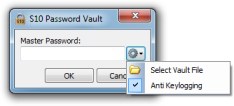 Advanced anti-keylogging - S10 Password Vault can also protect its own password fields from malicious keyloggers by sending lots of random hidden decoy keystrokes; keyloggers might see over 100 random characters, completely obscuring the actual password you typed. Enable this via the "Anti Keylogging" option next to the master password. With other password managers, keyloggers would capture your master password (and all account passwords you add) in clear text.
Advanced anti-keylogging - S10 Password Vault can also protect its own password fields from malicious keyloggers by sending lots of random hidden decoy keystrokes; keyloggers might see over 100 random characters, completely obscuring the actual password you typed. Enable this via the "Anti Keylogging" option next to the master password. With other password managers, keyloggers would capture your master password (and all account passwords you add) in clear text.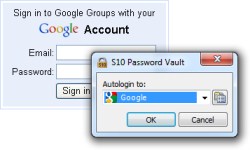 Account selection - When you use an autotype command, you may be asked to confirm which account to use. It defaults the appropriate account based on the title of the current website/program window. The prompt is skipped if there is exactly one matching account, or if there are multiple matches but only one strong-match account (title and server), or if you launched the website/program from S10 Password Vault and its window title matches the info for the account from which you launched.
Account selection - When you use an autotype command, you may be asked to confirm which account to use. It defaults the appropriate account based on the title of the current website/program window. The prompt is skipped if there is exactly one matching account, or if there are multiple matches but only one strong-match account (title and server), or if you launched the website/program from S10 Password Vault and its window title matches the info for the account from which you launched.
If you wish to edit account information instead of continuing with the autotype command, just click the Account Details icon. If you wish to add a new account, select the appropriate folder and then click the icon (which changes to a New Account icon when no account is selected).
 System tray icon - S10 Password Vault shows up in the system tray as a padlock icon. When you close the main window, S10 Password Vault keeps running in the background. To open it again, just click the icon. You can lock the program and also launch websites/programs or view accounts directly from the icon's right-click menu. A yellow icon indicates unlocked state; red means it is locked. To exit the program, right-click the icon and select Exit.
System tray icon - S10 Password Vault shows up in the system tray as a padlock icon. When you close the main window, S10 Password Vault keeps running in the background. To open it again, just click the icon. You can lock the program and also launch websites/programs or view accounts directly from the icon's right-click menu. A yellow icon indicates unlocked state; red means it is locked. To exit the program, right-click the icon and select Exit.Auto-lock timeout - For extra security, S10 Password Vault auto-locks by default after 5 minutes of being inactive in the background. The number of minutes is configurable via the Options window.
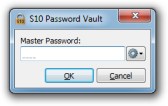 |
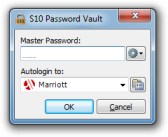 |
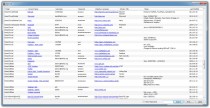 View All - S10 Password Vault includes a "View All" window that lets you see all information for all your accounts in spreadsheet format, sortable by column. Also includes a free-text search feature.
View All - S10 Password Vault includes a "View All" window that lets you see all information for all your accounts in spreadsheet format, sortable by column. Also includes a free-text search feature.Printing - You can print out the vault contents if you wish to keep a hard-copy backup in a safe place.
Import/Export - Ability to import data from, or export to, a tab-delimited text file (one account per row: folder\subfolder\name, username, password, website/program, window title, notes) - to see an example of this format, just create a dummy account and export it, then examine the file. Also supports import from KeePass v2 xml-formatted export files.
Export to Favorites - Also included is the ability to export website URLs to the Favorites menu in Internet Explorer. If you use another browser, you can just use that browser's capability to import bookmarks from Internet Explorer.
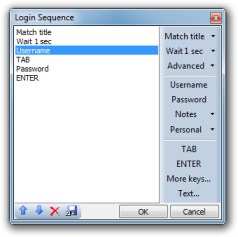 Login Sequence - For each website/program, you can specify whether or not it should automatically log you in when launched (No/Fill/Auto/Custom). "Fill" remembers where you autotype username/password and will then fill these and log in automatically next time you launch the site (IE only). "Auto" will first wait for a window title match, then wait 1 sec, then do an autologin (Username TAB Password ENTER). "Custom" offers many login step types:
Login Sequence - For each website/program, you can specify whether or not it should automatically log you in when launched (No/Fill/Auto/Custom). "Fill" remembers where you autotype username/password and will then fill these and log in automatically next time you launch the site (IE only). "Auto" will first wait for a window title match, then wait 1 sec, then do an autologin (Username TAB Password ENTER). "Custom" offers many login step types:
• Match title (account-specified title, or specific title)
• Wait 1 second (or any number of seconds up to 20)
• Wait for focus (for fields in IE or in program windows)
• Set focus / Click item
• Javascript (for IE/Chrome browsers; executes custom script code)
• Custom info fields (if defined for current account)
• Personal info fields (if defined; see Tools menu)
• Keys (lets you send keyboard commands, like Alt, Ctrl, arrows, etc)
• Text (lets you send any text, %FieldName% items, and can optionally end with TAB or ENTER)
• Wait 1 second (or any number of seconds up to 20)
• Wait for focus (for fields in IE or in program windows)
• Set focus / Click item
• Javascript (for IE/Chrome browsers; executes custom script code)
• Custom info fields (if defined for current account)
• Personal info fields (if defined; see Tools menu)
• Keys (lets you send keyboard commands, like Alt, Ctrl, arrows, etc)
• Text (lets you send any text, %FieldName% items, and can optionally end with TAB or ENTER)
Maximum allowed time for a login sequence is 60 seconds. Note: If the default focus in the program/website is not on the username field, be sure to insert the step "Set focus / Click item" before the "Username" step.
Standalone Launch Scripts - The "Save" button in the above Login Sequence window allows you to create a standalone script file that, when double-clicked, will launch the specified website/program and auto-login via the specified login sequence. The script contains all necessary info and is therefore independent of the vault file. Beware though that no password is required to launch a script file, so its information is not protected as securely as in the vault file (scripts use a static encryption key compiled into the S10 Password Vault program). Scripts have the extension ".s10s", and will automatically launch with the S10 Password Vault program (if you used the standard installer); alternatively you can create a shortcut to S10 Password Vault with the script file as input parameter. As a security feature, scripts can optionally be restricted to run only under a specific Windows user a account.
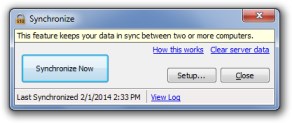 |
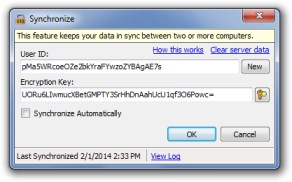 |
Since this feature uses server-side resources, a small donation or a business license is required to obtain your own user ID.
The data is first strongly encrypted locally on your PC using a full 256-bit key generaterated by you (not password-based), and then uploaded to a web server and stored under a unique user ID assigned to you. The encryption key is only known to you, which means it is completely impossible for either the server or any network monitoring tools to ever decrypt your data. For more information, see the full encryption details.
You can try out the feature using the public DemoUser1 or DemoUser2 user IDs, but beware that other users can of course overwrite the data at any point. A real user ID is a long generated string - impossible to guess, but even if someone does get a hold of your user ID it is still impossible for them to decrypt your data. Nevertheless, the user ID is transmitted securely encrypted in order to keep it private between you and the server.
Each time the synchronization process is invoked, it first downloads your data from the server, then reconciles this data, and finally uploads the latest, reconciled data (if necessary). You have the option to invoke the synchronization either manually or automatically. For manual invocation, use the Synchronize Now button in the Synchronization window. If done automatically, it will attempt to synchronize when: 1) you first open a vault, 2) you unlock and the last sync was over 24 hours ago, 3) half a minute before auto-locking if any edits have been made, 4) when you click OK in the Synchronization window after editing the key or user ID.
To get started:
- Click Tools->Synchronize; if you have made a donation and properly put the S10_Donation.txt file in your Documents folder, your User ID is automatically filled in. An encryption key is automatically generated too; you can click the Key icon to generate a different one if you wish. Click Ok.
- Click the "Synchronize Now" button and make sure it completes successfully.
- Install S10 Password Vault on the other PC (same version as on the first PC) and copy your S10_Donation.txt file to this PC. Don't start the program on this PC yet (click Tools->Exit if it is running).
- Copy your vault file to the other PC; it's in your Documents folder and it's named "Password Vault.s10p" (although Windows may suppress the ".s10p" extension).
- Now the two PC's are in sync. Whenever you add/change an account, click "Synchronize Now" (uploads it to your account), and then on the other PC click "Synchronize Now" and you should see the new/changed data.
Note that for bandwidth reasons, synchronization is not supported for vault files over 1MB (which can happen if you have large attachment files).
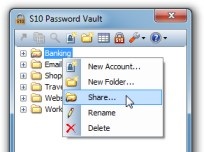 Sharing Folders - If you use Synchronization, you can also take advantage of the folder sharing feature, which lets you securely share and synchronize data with other users. For example, maybe you share financial accounts with your spouse, or maybe you want to share some info with team members at work.
Sharing Folders - If you use Synchronization, you can also take advantage of the folder sharing feature, which lets you securely share and synchronize data with other users. For example, maybe you share financial accounts with your spouse, or maybe you want to share some info with team members at work.
Right-click a folder and select Share, then generate a new encryption key, leave "User ID of Owner" blank (it's you), and click OK. Give this encryption key and your user ID to the person(s) you are sharing with, who should then enter this info in the Share window for their own corresponding folder (they should put your user ID in the field "User ID of Owner"). Before they can set up Sharing, they must have Synchronization set up with their own encryption key and user ID. Once the first user Synchronizes, the second user can Synchronize and see the accounts in the shared folder. The second user can then make changes too.
To try out this feature, you can use DemoUser2 when setting up Synchronization for the second user. For technical details, see the full encryption details.
Auto-start - S10 Password Vault is configured to start automatically in the background when Windows starts up. You can modify this behavior under Tools/Options.
Automatic file backup - When you open a password vault file, it will automatically make a backup copy of itself and save it under the same filename appended with "_backup". So if you accidentally delete an account or forget a newly changed master password, you can revert back to a previous version of the vault file. Beware that you should still back it up periodically to another place to keep your data safe in case your harddisk ever fails.
Digitally signed - No embedded spyware/adware or other third-party software. Both the install package and the program executable are digitally signed by S10 Software for your security.
Compact program size - Every feature in S10 Password Vault is carefully designed to minimize the impact on the overall program size by using efficient coding techniques and leveraging .NET Framework components. The download is 535KB (only 375KB for the USB-drive zip file!) - far below other programs in its class.
Disclaimers - This software is provided "as is" and without warranties of any kind. No official support is provided. In no event shall S10 Software or the author be held liable for any damages whatsoever arising from the use or inability to use the software. S10 Software is not obligated to provide maintenance releases or updates for the software.
Copyright - This software is protected by copyright laws and international copyright treaties, as well as other intellectual property laws and treaties. You may not reverse engineer, de-compile or disassemble the software. S10 Software shall retain title and all ownership rights to the software.
Distribution - This software may be freely distributed provided that it is not modified and the original archive remains intact with all accompanying files.
Business benefits - Increase employee productivity and close security gaps. See S10 Password Vault for business.
Version History - See a list of new features for each version in the full version history
PAD file - Portable Application Description file available at http://www.s10soft.com/pad/S10PasswordVaultPad.xml
FAQ - "My master password doesn't work anymore. What should I do?"
- We cannot reset it for you. Your data is encrypted with the master password you chose - the only way to decrypt it is with that specific password. This is explained in the "Master Password" section above.
- Try clicking the options button next to Master Password and make sure "Anti Keylogging" is not enabled; you may have some software/hardware that interferes with this feature and may therefore cause the master password to be captured improperly.
- If you're trying to use S10 Password Vault on a new PC, you need to copy over your data file "Password Vault.s10p" in your Documents folder to the new PC. Note that Windows may be hiding the ".s10p" extension in the file name.
- If you moved your data file to some other location, tell the program where it is by clicking the options button next to Master Password and then clicking "Select Vault File".
- If you changed your master password but then forgot what you changed it to, you can revert to the previous data file by first moving the data file to some other folder, and then renaming the file "Password Vault.s10p_backup" to "Password Vault.s10p". The backup file is a copy taken when you last successfully logged in.